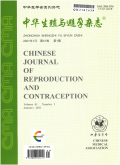维生素D缺乏对PCOS和卵巢储备功能正常女性IVF-ET助孕结局的影响
Effects of vitamin D deficiency on IVF-ET pregnancy outcomes in women with PCOS and normal ovarian reserve
摘要目的:探究维生素D缺乏对多囊卵巢综合征(polycystic ovary syndrome,PCOS)和因输卵管因素或男方因素致不孕的卵巢储备功能正常(normal ovarian reserve,NOR)患者体外受精-胚胎移植( in vitro fertilization and embryo transfer,IVF-ET)助孕结局的影响。 方法:通过回顾性队列研究,选取2018年1月至2023年12月期间于郑州市妇幼保健院生殖遗传科首次行IVF-ET的不孕女性,其中PCOS患者318例(P组),NOR患者528例(N组)。根据血清25羟维生素D[25(OH)D]水平将每组分为3个亚组:严重缺乏亚组[25(OH)D<12 μg/L]、缺乏亚组[12 μg/L ≤25(OH)D<20 μg/L]和非缺乏亚组[25(OH)D≥20 μg/L]。分析维生素D缺乏对两组患者助孕结局的影响。再采用1∶1倾向性评分对两组患者的基本资料进行匹配,匹配到P组和N组患者各158例,比较两组患者在相同维生素D状态下的助孕结局。结果:①PCOS患者亚组间一般资料和助孕情况差异均无统计学意义(均 P>0.05);严重缺乏亚组的双原核(two pronuclei,2PN)率[59.93%(721/1 203)]显著低于缺乏亚组[63.70%(1 032/1 620)],差异具有统计学意义( P=0.045),且二者均低于非缺乏亚组[68.06%(554/814)],差异均具有统计学意义( P<0.001, P=0.037);亚组间获卵数、MⅡ卵数、MⅡ卵率、2PN数、2PN率、卵裂数、卵裂率、第3天(day 3,D3)可用胚胎数、D3优质胚胎数、D3优质胚胎率、临床妊娠率、胚胎着床率、早期流产率、活产率和早产率差异均无统计学意义(均 P>0.05);女方年龄( OR=0.930,95% CI:0.871~0.992, P=0.028)、移植日子宫内膜厚度( OR=0.877,95% CI:0.791~0.971, P=0.012)、D3优质胚胎数( OR=1.135,95% CI:1.050~1.228, P=0.001)和促排卵方案( OR=2.230,95% CI:1.153~4.314, P=0.017)为临床妊娠的独立影响因素。②NOR患者亚组间一般资料、助孕情况、胚胎实验室参数和助孕结局相关的观察指标差异均无统计学意义(均 P>0.05);女方年龄( OR=0.944,95% CI:0.900~0.990, P=0.018)、D3优质胚胎数( OR=1.070,95% CI:1.004~2.597, P=0.037)和移植胚胎数( OR=1.753,95% CI:1.184~2.597, P=0.005)是临床妊娠的独立影响因素。③匹配后P组和N组间基本资料和助孕情况差异均无统计学意义(均 P>0.05);在维生素D严重缺乏状态下,P组的MⅡ卵率[76.64%(525/685)]、2PN率[59.69%(345/578)]、胚胎着床率[35.71%(30/84)]和活产率[34.00%(17/50)]显著低于N组[81.58%(465/570), P=0.033;67.00%(335/500), P=0.013;51.28%(40/78), P=0.046;55.32%(26/47), P=0.035];在维生素D缺乏状态下,P组的2PN率[66.50%(532/800)]显著低于N组[72.00%(725/1 007), P=0.012]。 结论:维生素D缺乏可能对PCOS患者IVF-ET助孕结局产生不利影响,且在严重缺乏状态下表现更明显,但对NOR患者的助孕结局无影响。
更多相关知识
abstractsObjective:To investigate the impact of vitamin D deficiency on the outcomes of in vitro fertilization and embryo transfer (IVF-ET) in women with polycystic ovary syndrome (PCOS) and normal ovarian reserve (NOR). Methods:A retrospective cohort study was conducted on infertile women undergoing their first IVF-ET cycle in the Department of Reproductive Genetics, Zhengzhou Maternity and Child Health Care Hospital from January 2018 to December 2023, including 318 PCOS patients (group P) and 528 NOR patients (group N). Each group was divided into three subgroups according to serum 25-hydroxyvitamin D [25(OH)D] levels: severe deficiency [25(OH)D<12 μg/L], deficiency [12 μg/L≤25(OH)D<20 μg/L], and non-deficiency [25(OH)D≥20 μg/L]. The impact of vitamin D deficiency on pregnancy outcomes was analyzed in each group. 1∶1 propensity score matching was applied to match the baseline characteristics between group P and group N , resulting in 158 matched cases of PCOS (group P) and NOR (group N). Pregnancy outcomes were compared between the two groups under the same vitamin D status.Results:1) Among PCOS patients, there were no significant differences in general characteristics and pregnancy outcomes among the three subgroups (all P>0.05). The two pronuclei (2PN) rate in the severe deficiency subgroup [59.93% (721/1 203)] was significantly lower than that in the deficiency subgroup [63.70% (1 032/1 620)], with a statistically significant difference ( P=0.045), and both were lower than that in the non-deficiency subgroup [68.06% (554/814)], with a statistically significant difference ( P<0.001, P=0.037). There were no statistically significant differences in the number of oocytes retrieved and MⅡ oocytes, MⅡ oocyte rate, 2PN number, 2PN rate, cleavage number, cleavage rate, number of available embryos on day 3 (day 3, D3), number of high-quality embryos on D3, D3 high-quality embryo rate, clinical pregnancy rate, embryo implantation rate, early miscarriage rate, live birth rate, and premature birth rate among subgroups (all P>0.05). Female age ( OR=0.930, 95% CI: 0.871-0.992, P=0.028), endometrial thickness on the day of transfer ( OR=0.877, 95% CI: 0.791-0.971, P=0.012), number of D3 high-quality embryos ( OR=1.135, 95% CI: 1.050-1.228, P=0.001), and ovulation stimulating protocol ( OR=2.230, 95% CI: 1.153-4.314, P=0.017) were independent factors influencing clinical pregnancy. 2) Among NOR patients, there were no significant differences in general characteristics, pregnancy outcomes, laboratory parameters, or other outcome-related indices among the three subgroups (all P>0.05). Female age ( OR=0.944, 95% CI: 0.900-0.990, P=0.018), number of D3 high-quality embryos ( OR=1.070, 95% CI: 1.004-2.597, P=0.037), and number of transferred embryos ( OR=1.753, 95% CI: 1.184-2.597, P=0.005) were independent factors influencing clinical pregnancy. 3) After matching, there were no significant differences in baseline characteristics and pregnancy outcomes between group P and group N (all P>0.05). In the severe vitamin D deficiency state, group P had significantly lower MⅡ oocyte rate [76.64% (525/685)], 2PN rate [59.69% (345/578)], embryo implantation rate [35.71% (30/84)], and live birth rate [34.00% (17/50)] compared with group N [81.58% (465/570), P=0.033; 67.00% (335/500), P=0.013; 51.28% (40/78), P=0.046; 55.32% (26/47), P=0.035]. In the vitamin D deficiency state, the 2PN rate in group P [66.50% (532/800)] was significantly lower than that in group N [72.00% (725/1 007), P=0.012]. Conclusion:Vitamin D deficiency may adversely affect IVF-ET outcomes in patients with PCOS, with more pronounced effects in cases of severe deficiency. However, it has no impact on the assisted reproductive outcomes in NOR patients.
More相关知识
- 浏览7
- 被引0
- 下载3


相似文献
- 中文期刊
- 外文期刊
- 学位论文
- 会议论文



 换一批
换一批 换一批
换一批



